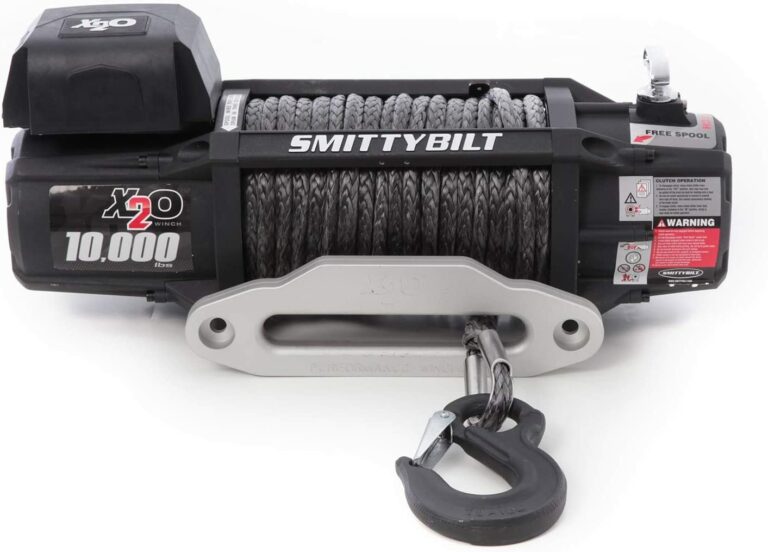Whether you need to winch a buddy out of a ditch or remove an old tractor from a field, trailer winches may be useful. There are several recreational and professional applications for trailer winches. You’ll start to wonder how you ever got by without one after you install a winch to your car trailer. It won’t take you long if you’re looking for a lifting winch to understand there are a surprisingly large number of winches available on the market. Knowing which winch is, therefore, worthwhile!
How to find the right winch size for car trailer ?
A winch’s capacity and pulling force are heavily influenced by its size. Larger winches may provide more torque to draw heavier vehicles like trucks since they are probably more powerful than smaller ones.
Going for the most oversized winches, regardless of the size of your trailer, is not a smart idea, as trailers frequently cannot sustain winches of all sizes. On the other hand, buying a small winch wouldn’t be a good idea either because it would be more likely to fail and less dependable than you would need in an emergency.
The gross weight of the automobile you are towing and the winch rated capability are the two key elements you must take into account in this respect. The GVW[1], or gross vehicle weight, accounts for the vehicle’s curb weight as well as the load within the vehicle from stowed cargo or people.
- Know the rated capability of your winch
- Calculate the GVWR of Car trailer
Right Winch = 1.5 * GVWR
TIP: Add 30% extra load pulling capacity to what you need.
Things to keep in mind
Before purchasing the best winch for your car trailer, there are unquestionably some additional aspects that you must consider. Prioritize keeping a budget in mind when you search for possibilities, but keep in mind that if you get anything cheap, it will end up costing you more in the long run. As a result, you shouldn’t be concerned about paying a little additional money if you want to get one that is trustworthy and durable.
Size
The winch capacity should be taken into account first and foremost. A winch with a larger winch capacity is usually preferable! In addition, you’ll want a more powerful winch the heavier the car is. At least 1.5 times your vehicle’s weight must be able to be pulled by your winch.
You can figure it out by multiplying the gross vehicle weight by 1.5. Although this is the minimum rating, there are several circumstances in which your winch capacity may be surpassed.
GVWR = Base Weight + Passengers / Cargo
Best winch Size >= GVWR x 1.5
Choose a winch with a minimum capability of 6000 labs if your vehicle weighs 4000 lbs. The industry norm is the 1.5X rule. But you should choose one with a capacity greater than that for better safety.
Rolling Load
After figuring out the GVW, you must figure out the rolling load. Tractors, vehicles, and boats are frequently towed onto the trailer bed using winches for car trailers. Thankfully, the majority of these loads have wheels and are categorized as rolling loads.
The rolling load typically represents one-fourth of the overall vehicle weight. This enables the winch to draw a load greater than it is rated to lift.
But it would help if you also considered the terrain, tire weight, and slope. So, be careful to pick a winch that has the same pulling capacity as the vehicle you intend to tow.
Pull capacity
When choosing a winch, one consideration is its size or capacity. The phrase “Pull Rating” first appears here. It specifies how much weight it can lift before failing and is expressed in pounds. The drum line (cable) and the winch elements are mechanically more robust the greater the number of pounds.
When Overlanding[2], this amount should be between 8,000 and 12,000 pounds for the majority of recovery missions.
How can you determine the type of pulling power your specific vehicle needs? The Gross Vehicle Weight, or GVW, is the first figure you need to ascertain. You should utilize the vehicle’s weight when it is fully loaded. This includes all your equipment, such as your roof tent and cargo crates.
The pound rating or capacity of your vehicle may be calculated by adding 30–50% to your vehicle’s weight (or GVW). For instance, if the GVW of a fully loaded rig is 6,000 pounds, your winch should have an 8,000-pound rating. Anything less won’t have the strength to get you out of difficulty.
Most off-roaders would advise you to use the larger draw capacity if you’re having difficulties picking or are somewhere in the center with your GVW plus 40%. However, too much power is never a bad thing. Additionally, the motor in your winch will last longer if you don’t put it under too much strain.
Electric or hydraulic
Electric and hydraulic winches are the two most common kinds. You want an electric recovery winch if you’re traveling off-road and require one.
Electric winches wind more quickly and effectively. They aren’t made for heavy-duty, 24/7 usage, so it’s smart to have one on hand when you periodically get stuck. You are constrained by how much power your car’s battery has because they are powered by it.
A few cables will flow from your battery and connect to the winch, enabling it to operate. The two are easily connected because the wiring flows underneath the hood; a DIYer may do the task with little difficulty.
Since electric winches are the most widely used and offer a wide range of options at prices that may accommodate a range of budgets, they are used by most overlanders.
Instead of connecting to your battery, hydraulic winches link to your steering pump. Although they aren’t quick, they make up for it with dependability. These are more frequently seen on vehicles that will be used and where very big loads need to be transported.
Hydraulic winches are incredibly durable and can operate nonstop for the entire day. In the world of winches, they are the workhorses.
However, they require expert installation and are not simple to set up. Moreover, they are overkill for particular purposes. All we need is an electric winch and a few other pieces of recovery equipment should we run into problems on the route.
Type of cable to use
There is much confusion about whether to use steel cable or synthetic rope.
- Steel Rope: This rope is inexpensive, strong, and very simple to maintain. However, one drawback is that it can be too hefty for the front of your setup. They work best in extremely harsh environments.
Steel rope is a wonderful option if you frequently drive over sand, dirt, and rocks. You must put on thick gloves when handling the rope to safeguard your hands due to the risk of unintentional hand injury from a steel cable. - Synthetic Rope: Compared to the steel cable, this is more flexible, safer, lighter, and simpler to handle. You can manage them without a glove. They work well as recovery and trail winches. However, its vulnerability to chemicals, UV light, heat, and abrasion is a drawback. Additionally, adequate upkeep and care are necessary for synthetic rope. You need to wash them sometimes after using them in muddy or sandy areas.
Warranty
Several companies provide comprehensive electrical and mechanical warranties for all of their goods. They provide a 100% satisfaction guarantee so that they may give you a refund for any reason. You could be required to cover the cost of postage if there is a return.
Once you have decided the right winch size for your car trailer and bought the best winch it time for your learn how to mount a winch on trailer and how to winch a car on a trailer.
Summary
Choosing the best winch size for your car trailer will undoubtedly be challenging. As a result, it’s essential to take the time necessary to select the ideal size for your needs. Make sure it can support the weight required for your application, which is more critical. The winch must also be robust and trustworthy in a variety of circumstances. We hope that this post has been very beneficial to you in this area.
References
Gonderman, J. (2021b). GVWR vs. GCWR: What’s the Difference, and Why Does It Matter? MotorTrend. https://www.motortrend.com/how-to/gvwr-vs-gcwr/
Segura, E. (2020). What is overlanding? An automotive overview of the awesome activity. MotorTrend. https://www.motortrend.com/news/what-is-overlanding/

